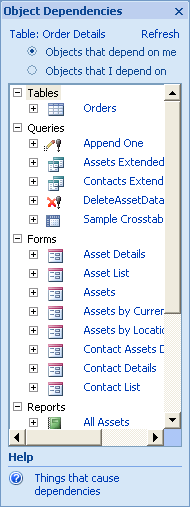The Object Dependencies pane in Access illustrates how database objects, such as tables, forms, queries, and reports, interact with or depend on other objects.
You can use the Object Dependencies pane to help avoid inadvertently deleting record sources. For example, suppose that you have a Quarterly Orders query in a Sales database, and you no longer need the query. Before you delete the query, you should find out if any of the other objects in the database, such as a form or report, use the query as a data source. You can then either modify the dependent objects to remove references to the query, or you can delete the dependent objects along with the query. Viewing a complete list of dependent objects can help you save time by removing the need to manually check object properties and minimize errors by finding the details that a manual audit might miss.
When you want to change the design of a database object, the Object Dependencies pane can also be useful by showing you how other objects will be affected by the design change. You should use the Object Dependencies pane to help you plan major design changes.
Use the Object Dependencies pane
-
Open the database that you want to investigate.
-
In the Navigation Pane, select or open a table, form, report, or query.
-
On the Database Tools tab, in the Relationships group, click Object Dependencies.
-
If prompted, click OK to update the dependency information.
Note: Updating dependency information may take some time.
The Object Dependencies pane appears.

-
To see a list of the objects that use the object that you selected in step 2, click Objects that depend on me at the top of the pane. To see a list of the objects that the selected object uses, click Objects that I depend on.
-
To see dependency information for an object, click the expand (+) icon next to that object. Access shows up to four levels of dependencies for an object.
Remember these facts as you use the Object Dependencies pane:
-
Dependency information is available only if you have permissions to open an object in Design view.
-
The pane does not show information for macros and code modules.
-
The pane works only for tables, forms, reports, and queries, except for the following types of queries:
-
Action queries — queries that insert, update, or delete data
-
SQL-specific queries, including union queries, data-definition queries, and pass-through queries
-
Subqueries
When Access encounters nested queries, dependency information is generated only for the outermost query. This rule also applies to the source tables and queries of a query's subdatasheet, and to lookup fields.
Note: In these types of cases, Access generally lists these objects in the Object Dependencies pane under the heading of Ignored Objects > Unsupported Objects.
-
-
Access generates dependency information by searching the name maps maintained by the name AutoCorrect feature — a feature that automatically corrects common side effects that occur when you rename forms, reports, tables, queries, fields, or controls on forms and reports. If tracking name AutoCorrect information is disabled, you will be prompted to turn it on before you can view the dependency information.
No comments:
Post a Comment